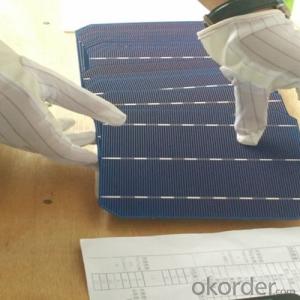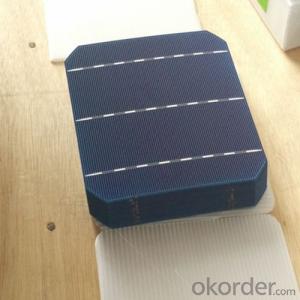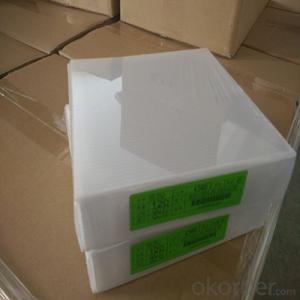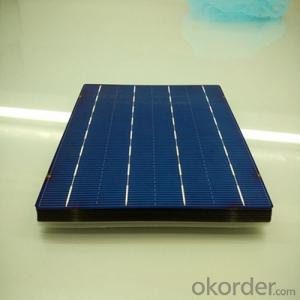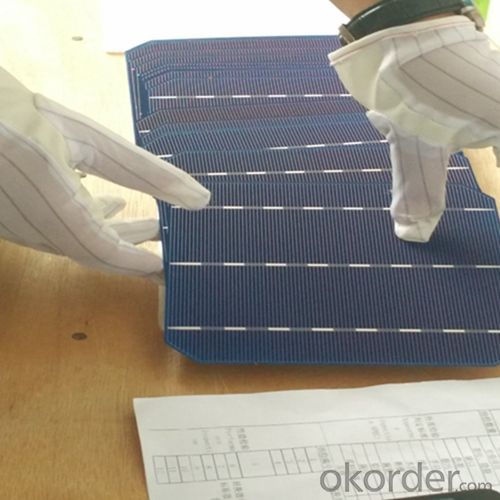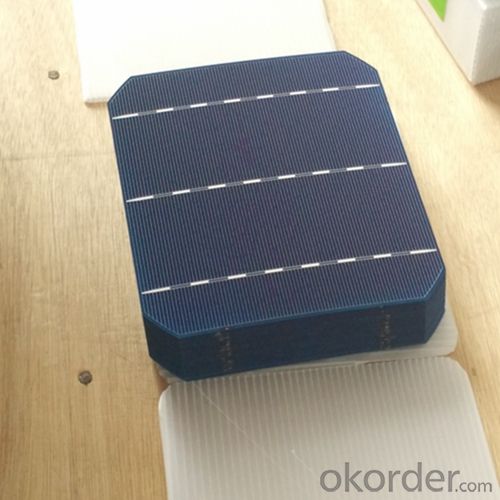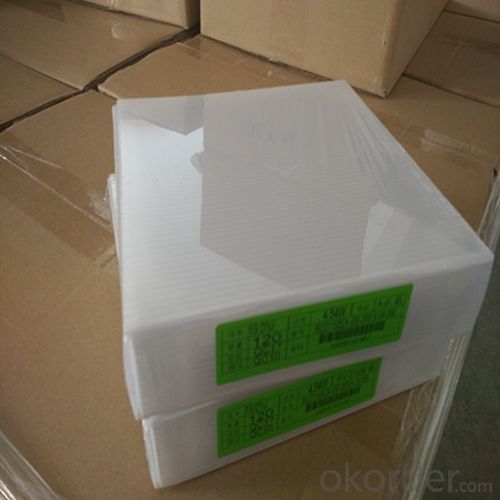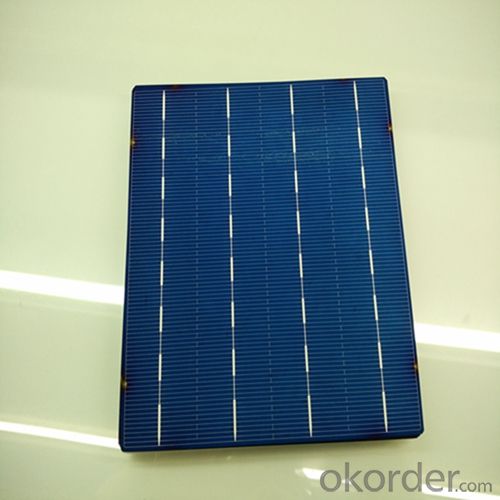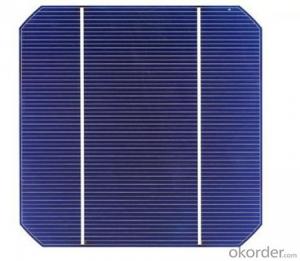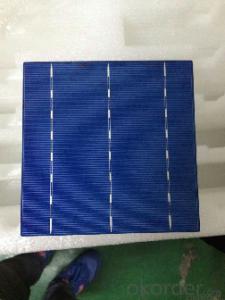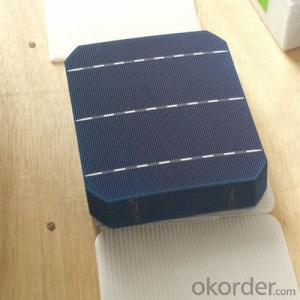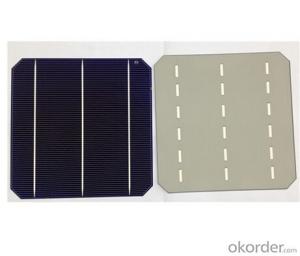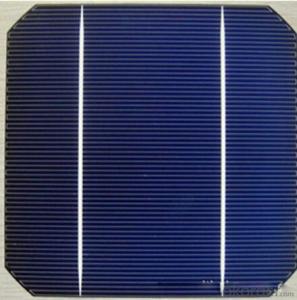Silicon Based Solar Cells - Mono 156x156mm2 Solar Cells Made in China
- Loading Port:
- Shanghai
- Payment Terms:
- TT OR LC
- Min Order Qty:
- 6000 watt
- Supply Capability:
- 6000000 watt/month
OKorder Service Pledge
OKorder Financial Service
You Might Also Like
The operation of a photovoltaic (PV) cell requires 3 basic attributes:
The absorption of light, generating either electron-hole pairs or excitons.
The separation of charge carriers of opposite types.
The separate extraction of those carriers to an external circuit.
In contrast, a solar thermal collector supplies heat by absorbing sunlight, for the purpose of either direct heating or indirect electrical power generation from heat. A "photoelectrolytic cell" (photoelectrochemical cell), on the other hand, refers either to a type of photovoltaic cell (like that developed by Edmond Becquerel and modern dye-sensitized solar cells), or to a device that splits water directly into hydrogen and oxygen using only solar illumination.Characteristic of Mono 156X156MM2 Solar Cells
You are gaining energy independence - add battery backup power for even greater energy security
The cost of electricity is only going to rise – insure against that rising cost
Adaptive cells change their absorption/reflection characteristics depending to respond to environmental conditions. An adaptive material responds to the intensity and angle of incident light. At the part of the cell where the light is most intense, the cell surface changes from reflective to adaptive, allowing the light to penetrate the cell. The other parts of the cell remain reflective increasing the retention of the absorbed light within the cell.[67]
In 2014 a system that combined an adaptive surface with a glass substrate that redirect the absorbed to a light absorber on the edges of the sheet. The system also included an array of fixed lenses/mirrors to concentrate light onto the adaptive surface. As the day continues, the concentrated light moves along the surface of the cell. That surface switches from reflective to adaptive when the light is most concentrated and back to reflective after the light moves along
Mechanical data and design
Format | 156mm x 156mm±0.5mm |
Thickness | 210μm±40μm |
Front(-) | 1.5mm bus bar (silver),blue anti-reflection coating (silicon nitride) |
Back (+) | 2.5mm wide soldering pads (sliver) back surface field (aluminium) |
Temperature Coefficient of Cells
Voc. Temp.coef.%/K | -0.35% |
Isc. Temp.coef .%/K | +0.024%/K |
Pm.Temp.coef. %/K | -0.47%/K |
Electrical Characteristic
Effiency(%) | Pmpp(W) | Umpp(V) | Impp(A) | Uoc(V) | Isc(A) | FF(%) |
18.35 | 4.384 | 0.526 | 8.333 | 0.63 | 8.877 | 78.39% |
18.20 | 4.349 | 0.526 | 8.263 | 0.63 | 8.789 | 78.54% |
18.05 | 4.313 | 0.525 | 8.216 | 0.63 | 8.741 | 78.32% |
17.90 | 4.277 | 0.524 | 8.161 | 0.625 | 8.713 | 78.04% |
17.75 | 4.241 | 0.523 | 8.116 | 0.625 | 8.678 | 77.70% |
17.60 | 4.206 | 0.521 | 8.073 | 0.625 | 8.657 | 77.36% |
17.45 | 4.170 | 0.519 | 8.039 | 0.625 | 8.633 | 76.92% |
17.30 | 4.134 | 0.517 | 8.004 | 0.625 | 8.622 | 76.59% |
17.15 | 4.096 | 0.516 | 7.938 | 0.625 | 8.537 | 76.80% |
17.00 | 4.062 | 0.512 | 7.933 | 0.625 | 8.531 | 76.18% |
16.75 | 4.002 | 0.511 | 7.828 | 0.625 | 8.499 | 75.34% |
16.50 | 3.940 | 0.510 | 7.731 | 0.625 | 8.484 | 74.36% |
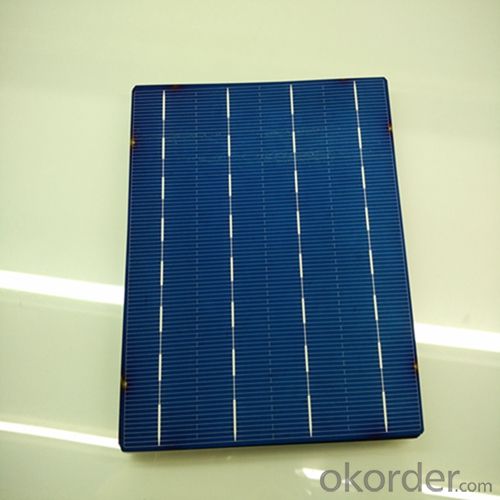
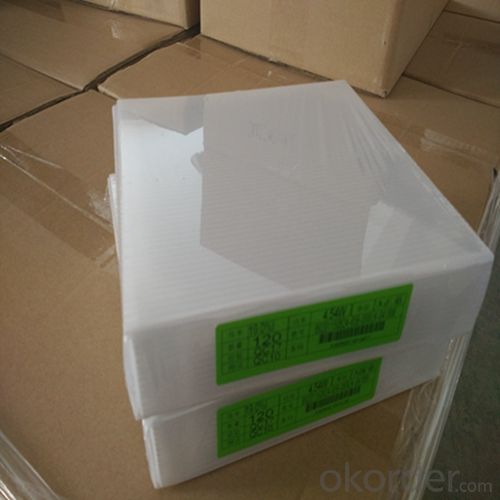
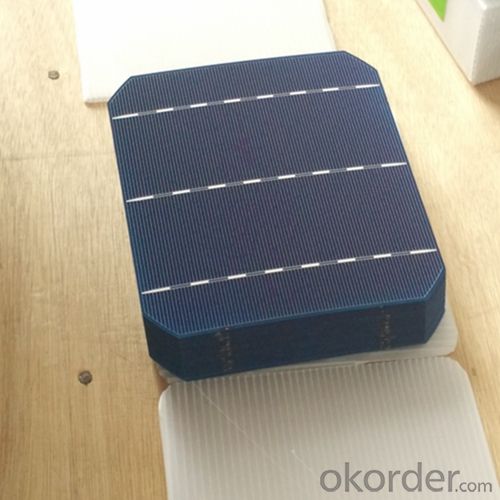
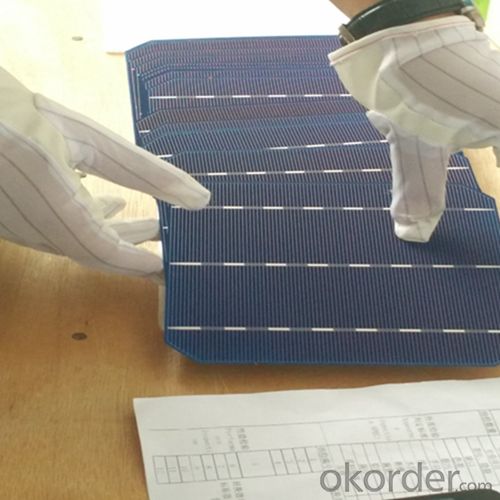
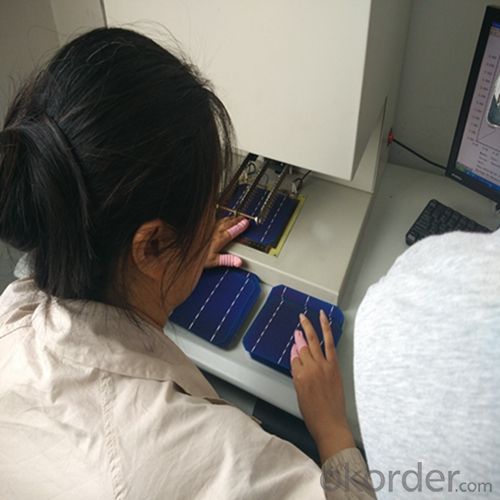 FAQ
FAQ
Q: What price for each watt?
A: It depends on the quantity, delivery date and payment terms, generally Large Quantity and Low Price
Q: What is your size for each module? Can you tell me the Parameter of your module?
A: We have different series of panels in different output, both c-Si and a-Si. Please take the specification sheet for your reference.
Q: What is your size for each module? Can you tell me the Parameter of your module?
A: We have different series of panels in different output, both c-Si and a-Si. Please take the specification sheet for your reference.
- Q: How does the efficiency of solar cells vary with different materials?
- The efficiency of solar cells varies with different materials due to their varying properties and characteristics. Some materials, like silicon, have high efficiency as they have a suitable bandgap for absorbing sunlight and converting it into electricity. Other materials, such as thin-film materials like cadmium telluride or perovskites, may have lower efficiency but offer advantages like flexibility or lower production costs. Overall, the efficiency of solar cells is highly dependent on the specific material used and its ability to convert sunlight into electrical energy effectively.
- Q: Are solar cells durable?
- Yes, solar cells are generally durable. They are designed to withstand various weather conditions, including rain, snow, and extreme temperatures. Additionally, most solar cells come with warranties that guarantee their performance for several decades.
- Q: Can solar cells be used in mountainous regions?
- Yes, solar cells can be used in mountainous regions. In fact, mountainous regions can often be advantageous for solar energy generation due to the higher altitude and reduced air pollution, which can result in increased solar radiation. However, the installation of solar panels may require careful consideration of factors such as slope, orientation, and potential shading from surrounding mountains or trees.
- Q: What is the impact of wind on solar cell efficiency?
- The impact of wind on solar cell efficiency is generally negative. Strong winds can create turbulence around solar panels, causing them to vibrate or move, which can potentially damage the cells or the overall system. Additionally, excessive wind can lead to dust and debris accumulation on the surface of the panels, reducing their ability to absorb sunlight and convert it into electricity efficiently. Therefore, it is important to consider the effects of wind and implement proper measures, such as secure mounting and regular cleaning, to minimize any negative impact on solar cell efficiency.
- Q: How do solar cells generate electricity at night?
- Solar cells do not generate electricity at night because they rely on sunlight to produce an electric current. During the night, there is no sunlight available for the solar cells to convert into electricity.
- Q: How do solar cells impact energy independence?
- Solar cells impact energy independence by harnessing the power of the sun to generate electricity, reducing reliance on traditional fossil fuels. By providing a clean and renewable source of energy, solar cells contribute to reducing greenhouse gas emissions and increasing energy self-sufficiency, ultimately enhancing a country's energy independence.
- Q: How many types of solar cells are now being used in real life?
- Generally, there are two types of solar cells, one is Monocrystalline silicon solar cells, the other is polycrystalline silicon solar cells
- Q: Can solar cells be used in off-grid water desalination?
- Yes, solar cells can be used in off-grid water desalination. Solar energy can power the desalination process, typically through a combination of solar panels and a renewable energy storage system. This allows for the conversion of saltwater into fresh water without the need for a connection to the electrical grid. The energy from the sun is harnessed, stored, and utilized to run the desalination equipment, making it a sustainable and environmentally friendly solution for off-grid water desalination.
- Q: Can solar cells be used for powering disaster relief operations?
- Yes, solar cells can certainly be used for powering disaster relief operations. Solar cells, also known as photovoltaic cells, convert sunlight into electricity, making them a reliable and sustainable source of power. In disaster-stricken areas where the conventional power grid may be disrupted or unavailable, solar cells can provide a clean and renewable energy solution. They can be used to charge batteries, power communication devices, run medical equipment, and provide lighting and electricity for essential services such as shelters, water purification systems, and refrigeration for medical supplies. Furthermore, solar cells are portable and can be easily deployed to remote or inaccessible areas, making them an ideal choice for disaster relief efforts.
- Q: How is the solar cells factories working in China? Do they follow certain quality standards?
- The solar cells factories are pretty good, at least based on my personal experience. I went to visit one of the solar cell factory based in Shandong province, and they are quite professional.
Send your message to us
Silicon Based Solar Cells - Mono 156x156mm2 Solar Cells Made in China
- Loading Port:
- Shanghai
- Payment Terms:
- TT OR LC
- Min Order Qty:
- 6000 watt
- Supply Capability:
- 6000000 watt/month
OKorder Service Pledge
OKorder Financial Service
Similar products
Hot products
Hot Searches
Related keywords
